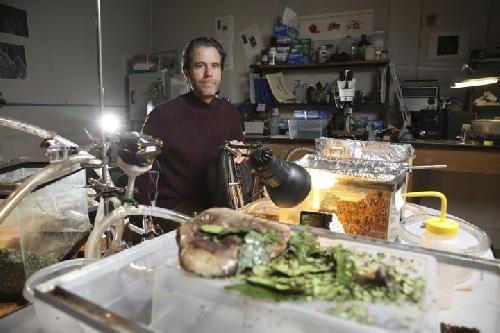EUGENE, Ore. -- Jan. 28, 2016 -- Deploying multiple videos in a University of Oregon lab, scientists have documented never-before-seen views of leafcutter ants at work processing leaves and growing their food supply in their nests.
In a paper published online Jan. 27 by the journal Royal Society Open Science, Robert Schofield and colleagues detail the ants' prehensile skills and shed new insights on the various behaviors associated with gathering leaves, delivering them to their nests and processing them grow the fungus that nourishes a colony.
Leafcutter ants are agricultural pests that range from the southern United States through much of South America. Their complex societies rely on a division of labor inside and outside their often-massive underground nests. Studying the ants, Schofield said, helps find ways to reduce the damages they and their nest cause and gather nature-based insights that could prove helpful to efforts to manufacture tiny machines and tools.
 University of Oregon physicist Robert Schofield stands behind the leafcutter ant colony that he maintains in his lab. He has studied leafcutters for several years, gathering information on the ants' division of labor and how leafcutters use their anatomy to complete tasks both inside and outside of their nests. Credit: Photo by Charlie Litchfield
University of Oregon physicist Robert Schofield stands behind the leafcutter ant colony that he maintains in his lab. He has studied leafcutters for several years, gathering information on the ants' division of labor and how leafcutters use their anatomy to complete tasks both inside and outside of their nests. Credit: Photo by Charlie Litchfield
In the study, Schofield's six-member team document how leafcutters hold, lick, scrape, cut and puncture the leaves they use. The study found that the ants are selective, choosing leaf pieces that are small and easy for them to transport, and that 90 percent of this processing work takes place in their nests.
The study also links to a six-minute summary video that puts the findings together and to shorter videos that focus on individual aspects of the ants' work. The videos emerged from more than 70 hours of observations in a leafcutter colony in Schofield's lab.
The summary video is at: https://www.youtube.com/watch?v=lHXxVckY-e0
"We show that the many-jointed leg tips, or tarsi, of ants can be prehensile, like many-jointed human fingers, grasping and manipulating work pieces with precision," said Schofield, a research professor in the UO Department of Physics. "The ants are remarkably handy, often using three legs as a tripod to stand on and the other three legs to handle leaf pieces as they cut, scrape, lick, puncture and chemically treat them. When the processing is complete, the ants rock the leaf fragments into the comb, much like stonemasons building a wall."
Schofield's team also analyzed the cutting, carrying and preparation of the leaves done by the ants to understand their energy expenditure. Much of this analysis involved fieldwork at leafcutter sites in Colombia and Ecuador. The researchers also calculated estimates of leaf-cutting density based on samples of transported leaf cuttings and fungal substrate from field colonies of the leafcutter species Atta cephalotes and Atta colombica.
The task-shared processes, the researchers concluded, suggest that energy conservation and the ants' division of labor are important to the overall health and survival of the ants.
source: University of Oregon